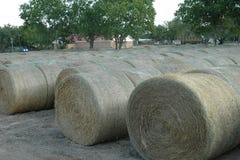July 9, 2015

In my neck of the woods, haying season is in full swing, and I’ve got the scratched up arms and farmer’s tan to prove it. While we’ve had some timely rains that have allowed our hay fields and pastures to thrive, we haven’t experienced delays in harvesting hay like other parts of the country have.
A recent BEEF survey revealed that readers plan to harvest more hay in 2015 than in the past; however, with rain and flooding delays, this could prove more difficult than anticipated. In this first segment of July’s “Hay Talk” series, we’re looking at why cutting height and moisture levels matter when baling hay.
If you’re still waiting to get your first cutting of hay down, Bruce Anderson, Nebraska Extension forage specialist, suggests producers evaluate the stand and consider raising the cutting height.

Photo Credit: Texas AgriLife
“Walk into your alfalfa field before cutting and look closely at the base or crown of the plants,” says Anderson. “Do you see short, new shoots starting to grow? If so, these new shoots are the new plants that your alfalfa hopes to turn into your second cutting. Look closely – how tall are these new shoots? Are many of them a couple inches taller than your usual cutting height? If you cut these new shoots off – along with the first growth – your alfalfa plants will have to start a whole new set of shoots for regrowth. This could cause a delay in second cutting regrowth by as much as one week.”
Fortunately, Anderson says producers can avoid this delay by simply raising the cutting height just a couple of inches to avoid clipping the new, second growth shoots.
“Your regrowth then will have a head start toward next cutting,” he says. “And since the stubble you leave behind has quite low feed value anyway, the yield you temporarily sacrifice is mostly just filler. Normally I suggest cutting alfalfa as short as possible because that maximizes yield and it doesn’t affect rate of regrowth. But a late cutting that already has new shoots growing is different. Don’t blindly start cutting alfalfa when harvest is delayed. First look for new shoots, then raise cutting height if needed.”
Of course, baling hay that hasn’t had a chance to cure is another common problem that is difficult to avoid when receiving a significant amount of rain.
According to Daniel Lima, Ohio State University Extension educator, “Moisture levels have a direct effect on hay quality. What I have found to be a consistent number in the literature is 20% moisture maximum.”
More specifically, small squares need to be at 20% moisture or less; large round bales need to be at 18% moisture or less; and large squares should be at 16%.
Lima says, “Hay baled at 20% moisture or higher has a high probability of developing mold, which will decrease the quality of hay by decreasing both protein and total nonstructural carbohydrates (TNC), aka energy. The mold will also make the hay less palatable to livestock and could potentially be toxic, especially for horses. Even hay baled between 15%-20% moisture will experience what is known as ‘sweating.’ Sweating, in regard to hay bales, refers to microbial respiration, which will create heat and result in dry matter (DM) loss. A good rule of thumb is that you should expect a 1% DM loss per 1% decrease of moisture after baling. As an example, hay baled at 20% moisture that is stored and dried down to 12%; will result in 8% DM loss.”
To ensure adequate livestock nutrition this winter, Lima recommends producers have a forage analysis done on the hay baled this year.
“Once you have those results, develop a corresponding supplemental feed program, if necessary, based on the nutritional requirements of your livestock,” Lima advises.
Click here to watch a video on how to take forage samples for testing.
Due to high moisture levels, some producers — particularly dairy operations —are looking at the concept of “haylage in a day,” which will be the topic of next week’s Hay Talk series.
How is baling going in your area? Have you been delayed due to rain? What are your strategies for putting up high-quality hay despite the extra moisture? Share your thoughts in the comments section below.
The opinions of Amanda Radke are not necessarily those of beefmagazine.com or Penton Agriculture.
You might also like:
How to prevent & treat pinkeye in cattle
Feedyard losses: How bad is it?
What's the best time to castrate calves? Vets agree the earlier the better
You May Also Like



